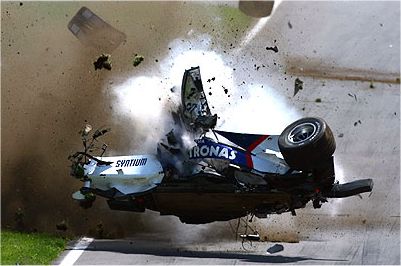
Although the driver looks like he is sitting outside the cockpit temperatures can soar almost out of control during the two hours of a race. Formula One cars don’t have the luxury of air conditioning, and the close proximity of the engine, which sits directly behind him, as well as the lack of air circulating in his cockpit, means that temperatures inside can often reach more than 10 degrees centigrade higher than the outside temperature. When you think that most Grands Prix take place in the middle of each country’s summer, it is not difficult to understand just how uncomfortable the temperature can be. In addition to the closeness of the engine, the cockpit is made hotter by the heat of the front-wheel’s brakes, which can often reach 1,000 degrees centigrade. Also impacting on the cockpit temperature is the driver’s seating position. He’s very close to the floor, which can get hot if it rubs along the ground. McLaren star David Coulthard climbed out of his car at the end of the 2000 Malaysian Grand Prix with a huge heat blister on his bottom thanks to the heat that was generated through the floor of the cockpit. Drivers also get very hot because of all the other clothing they must wear. The safety regulations require drivers to wear fireproof underwear, a triplelayer racing overall, plus gloves, boots, a balaclava and helmet – all of which make them even hotter.







